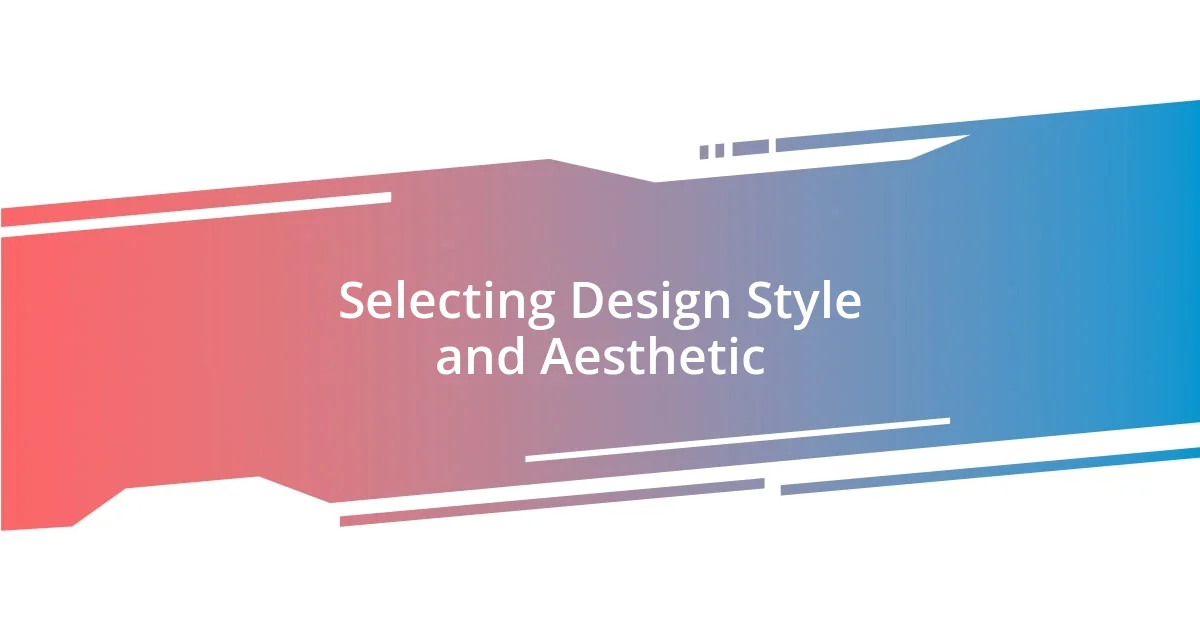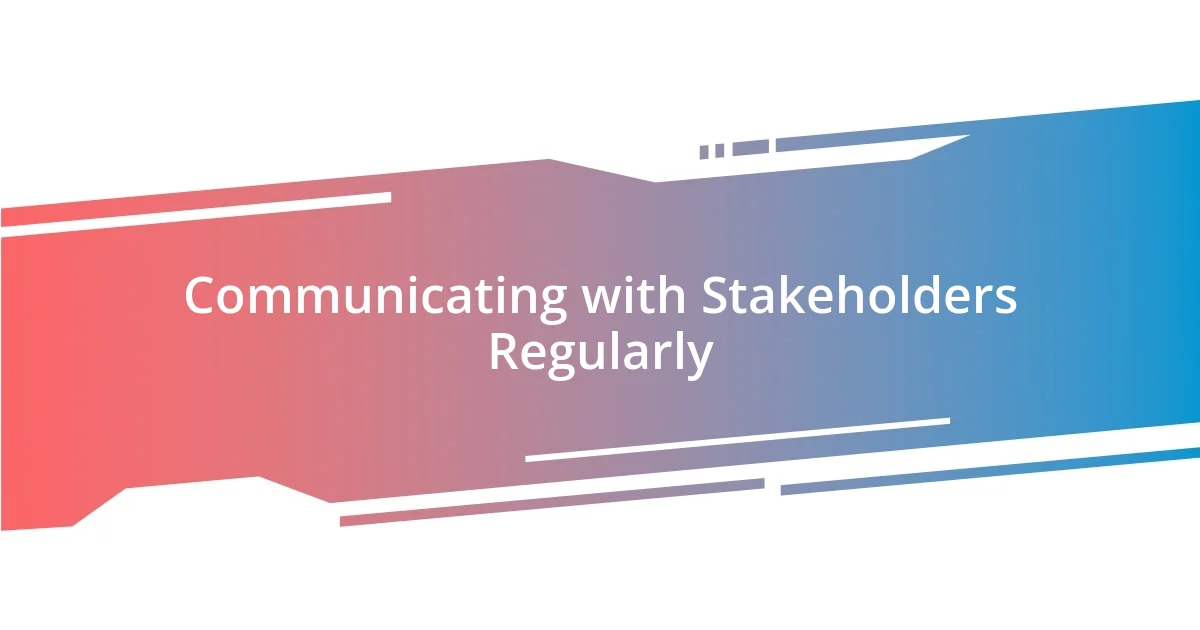Key takeaways:
- Understanding client objectives through open-ended questions enhances project alignment and personal connection.
- Clearly defining project scope, including objectives, deliverables, and budgets, fosters collaboration and keeps projects on track.
- Incorporating user feedback during the design process leads to meaningful improvements and stronger emotional connections with the final product.

Understanding Client Objectives
Understanding client objectives is crucial to the success of any custom design project. I’ve often found that a simple, open-ended question can lead to profound insights. For instance, asking clients, “What legacy do you want your project to leave behind?” can uncover their deeper motivations and aspirations, offering a clearer picture of their ultimate goals.
In a recent project, a client expressed a desire for a design that not only served a functional purpose but also resonated with their personal journey. This insight transformed the project; instead of a generic solution, I was able to create something truly reflective of their identity. It was amazing to see how aligning their objectives with my design approach resulted in a more meaningful outcome.
When I engage with clients, I also pay attention to their values and emotions. Have you ever noticed how a client’s excitement or hesitation can reveal their underlying priorities? Tuning into these emotions helps me tailor my work to fit their vision more precisely, ensuring that the final design doesn’t just meet expectations but exceeds them in a way that feels personal and authentic.

Defining Project Scope Clearly
Defining the project scope clearly is a foundation upon which successful custom design projects are built. I’ve learned that this clarity directly influences both the growth of the project and the satisfaction of all parties involved. For example, during one project, I had a client with an expansive vision, but without a clear scope, we found ourselves drifting away from the original idea. Setting precise boundaries helped us focus our creativity and resources effectively.
Here are a few key elements I prioritize when defining project scope:
- Objectives: What are the project’s main goals? This includes understanding what success looks like for the client.
- Deliverables: Clearly outline what will be provided at project completion, ensuring everyone has the same expectations.
- Timeline: Establishing deadlines helps keep the project on track and maintains a sense of urgency.
- Budget: Discussing financial limitations upfront greatly influences design decisions and expected deliverables.
- Stakeholders: Identify who is involved in the decision-making process to streamline communication and approvals.
When everyone is aligned and knows precisely what to expect, it fosters a collaborative and creative environment. I’ve found that this clarity not only eases the design process but also empowers my clients to feel more engaged and confident in the journey we embark on together.

Selecting Design Style and Aesthetic
Selecting the right design style and aesthetic is a pivotal step in shaping any custom design project. From my experience, each choice reflects not only functionality but also the personality and values of the client. I fondly recall a project where my initial design leaned heavily toward a minimalist approach, but after diving deeper into the client’s preferences, I discovered their passion for vibrant, expressive colors. This insight transformed the final product into a vivid narrative rather than a simple structure, reinforcing the idea that design is as much about emotional connection as it is about visuals.
When it comes to aesthetics, I often find myself weighing contemporary designs against timeless ones. In one memorable instance, I was torn between sleek modern lines and rustic textures for a client’s space. Ultimately, the client’s heartfelt stories about their family heritage guided my decision toward a more eclectic style that elegantly bridged the old with the new. It’s a reminder that the ultimate design should feel like a personal story, showcasing elements that resonate with the client’s journey and identity.
As I approach the selection of design styles, I also consider how each choice complements the overall vision of the project. For instance, are we aiming for an inviting atmosphere or a bold statement? I ask clients to visualize their ideal end result and what emotions they want to evoke within their audience. This dialogue not only enhances the design process but also builds a collaborative partnership that yields stunning results.
| Design Style | Key Characteristics |
|---|---|
| Minimalism | Function-oriented with clean lines and limited color palette. |
| Eclectic | Mixing various styles and influences, often rich in color and texture. |
| Contemporary | Current trends that often prioritize simplicity but can vary widely. |
| Timeless | Classic aesthetics that remain appealing over years, blending elegance with restraint. |

Integrating User Experience Principles
Integrating user experience (UX) principles into custom design projects is crucial for creating meaningful interactions. One project comes to mind where I deeply integrated user feedback into the design process. By inviting potential users to share their thoughts during prototyping, we were able to identify design flaws that could have been overlooked. This not only enhanced the final result but also made users feel valued, reinforcing the idea that their experiences should shape the outcomes.
I often find myself asking, “What truly makes an experience enjoyable?” For me, it’s about empathy and understanding the users’ needs. During a recent redesign of a website, I focused on simplifying navigation, keeping in mind that users often prefer intuitive experiences over elaborate designs. The warmth in their faces when they effortlessly found what they were searching for reminded me of the power of user-centric design. It’s always so rewarding to witness designs come alive through the users’ engagement with them.
In my experience, aligning design decisions with UX principles transforms projects into journeys of discovery. I remember a mobile app project where we prioritized accessibility. By consulting users with disabilities, we were able to create an inclusive design. It was an eye-opening experience that highlighted how design can either empower or hinder. When we prioritize the user experience, we go beyond aesthetics; instead, we craft solutions that unify functionality and deep emotional connections.

Managing Project Timelines Effectively
Managing project timelines effectively is a balancing act that I’ve honed over years of experience. I remember a particular project where my team and I faced unexpected delays. Instead of panicking, we regrouped and assessed our priorities, which not only helped us meet the deadline but also taught us the importance of flexibility in planning. Have you ever encountered a similar situation? It’s in those moments that staying organized and maintaining open communication with clients is essential.
Regularly updating clients on project milestones can ease anxiety and build trust. I always find that transparent communication around timelines keeps everyone on the same page. For example, in one project, my client was apprehensive about our progress. I scheduled weekly check-ins, which helped reassure them and foster a deeper relationship. This demonstrated to me that clients appreciate when you take the time to share the journey, not just the destination.
Time management also requires anticipating potential roadblocks before they become problematic. In one recent project, I set aside buffer time specifically for unforeseen challenges, a strategy that proved invaluable when a vendor missed a delivery. This proactive approach allowed us to shift tasks around without derailing the entire timeline. By thinking ahead, I’ve learned that we can maintain momentum and ensure projects flow smoothly, even in the face of unexpected surprises.

Communicating with Stakeholders Regularly
Communicating with stakeholders regularly is something I prioritize deeply in my design projects. I recall a project where I set up bi-weekly updates with stakeholders. At first, I was unsure if they would find it helpful, but to my surprise, these meetings became a highlight for everyone involved. The direct feedback and collaborative discussions fostered a sense of team spirit that I hadn’t anticipated. Have you ever felt that kind of connection? It’s truly energizing!
Maintaining an open channel of communication allows me to gauge stakeholder expectations and adjust accordingly. There was a time when a major design element was being questioned by a key stakeholder. Instead of waiting until the final review, I quickly organized a design sprint to address their concerns. This proactive step not only salvaged the relationship but also led to an even better solution than we initially had. It made me realize that timely communication can turn potential conflicts into opportunities for innovation.
I’ve learned that listening is just as important as speaking when it comes to stakeholder communication. In one of my recent projects, I made a habit of actively asking stakeholders for their input, often catching them off guard. Their insights reflected perspectives I hadn’t considered, which enriched the design process. Every conversation felt like a treasure hunt, uncovering valuable insights that guided our direction. So, why not embrace that collaborative spirit? After all, design is a shared journey toward a common goal, and keeping the lines of communication open enhances that experience for everyone involved.

Evaluating and Iterating on Designs
Evaluating and Iterating on Designs
In my custom design projects, evaluation and iteration are like breathing; they keep the process alive and evolving. I recall a project where we received feedback that a major component was too complex for users. Initially, it stung a little, but I quickly reminded myself that this was an opportunity for growth. Have you ever had your designs critiqued? Those moments, while challenging, are often where the best ideas emerge! By creating a prototype based on that feedback, we not only simplified the design but also enhanced user engagement significantly.
Iteration requires a mindset that views feedback as fuel rather than a setback. I once involved the end-users in testing a design early on. Their insights were invaluable, pointing out usability issues I hadn’t even considered. It was a bit humbling, to be honest. But this experience taught me that involving users leads to designs that truly resonate. Can you think of an instance where user feedback altered your design in ways you couldn’t imagine? For me, it’s a reminder that involvement leads to better outcomes.
Making time for reflection is crucial too. After completing a project, I always set aside a moment to analyze what worked and what didn’t. In one instance, I realized that a previously reliant feature had become obsolete. This reflection was a wake-up call, pushing me to adapt and innovate in future projects. By capturing these lessons, I ensure that every new design benefits from the experiences of those before it. Isn’t it exciting to think that each iteration can lead to something even better?















